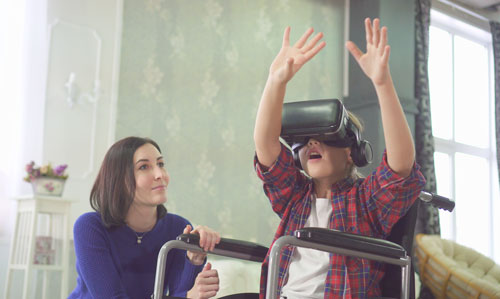For children with disabilities, everyday experiences like visiting a museum, attending a school trip, making a sandwich, or practicing social skills can be challenging. Virtual reality (VR) is making experiences like these more accessible by immersing kids in life-like, three-dimensional environments that feel safe and manageable.
According to Professor Emily Bouck at Michigan State University, “When students can safely practice everyday tasks in a simulated environment and retain that learning, it opens doors to greater independence.”
As Tech Target explains, “virtual reality, or VR, is a simulated three-dimensional (3D) environment that lets users explore and interact with a virtual surrounding in a way that approximates reality, as it’s perceived through the users’ senses. The environment is created with computer hardware and software, although users might also need to wear devices such as goggles, headsets or bodysuits to interact with the environment.”
The technology can help disabled children in a variety of ways.
VR provides a child with autism, for example, the opportunity to rehearse ordering food at a restaurant. A child who uses a wheelchair can experience rolling through a park or visiting a zoo or amusement park. Because virtual environments can be adjusted for noise, lighting and cognitive ability, therapists and teachers can customize the experience to each student. Children can repeat tasks as often as needed, helping build confidence and independence.
Though therapy can be hard work, VR makes it fun. Games that involve reaching, stretching or balancing help kids build coordination and strength. A pilot study by Byron Lai, Ph.D., with the University of Alabama Birmingham-Lakeshore Research Collaborative, even showed that VR can improve physical fitness levels of children who are sedentary due to mobility issues. The study found “that children who use wheelchairs could achieve unprecedented levels of health-enhancing exercise at home, using only their arms.”
Many VR programs are designed to help children practice social skills. These programs can help kids learn to read facial expressions, take turns or manage anxiety in a safe setting. Practicing these skills with VR can make joining a group activity or starting a conversation less intimidating.
VR can also help non-disabled people develop empathy by literally showing them how it feels to live with a disability. When students experience what it’s like to have low vision or limited mobility, they gain a better understanding of their peers’ challenges and strengths. This awareness leads to higher rates of inclusion and kindness in real life.
As virtual reality technology becomes more affordable and adaptable, its benefits for children with disabilities are expected to increase. Experts say that today’s VR tools are evolving quickly to meet a wider range of needs. According to EdTech Magazine, developers are creating lighter headsets, voice-activated controls, and new tactile feedback features to make VR experiences more inclusive for all learners.


